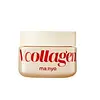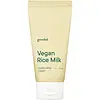What's inside
What's inside
 Key Ingredients
Key Ingredients

 Benefits
Benefits

 Concerns
Concerns

 Ingredients Side-by-side
Ingredients Side-by-side

Collagen Extract 36%
Skin ConditioningWater
Skin ConditioningPropanediol
SolventGlycerin
HumectantAcetylated Hydrogenated Vegetable Glyceride
EmollientHydrogenated Poly(C6-14 Olefin)
EmollientNiacinamide
SmoothingHelianthus Annuus Seed Oil
Emollient1,2-Hexanediol
Skin ConditioningAmmonium Acryloyldimethyltaurate/Vp Copolymer
Tremella Fuciformis Extract
HumectantLupinus Albus Seed Extract
Skin ConditioningLeuconostoc/Radish Root Ferment Filtrate
AntimicrobialRosa Damascena Flower Oil
MaskingRosa Damascena Flower Water
MaskingCollagen
MoisturisingButylene Glycol
HumectantTocopherol
AntioxidantLecithin
EmollientPentylene Glycol
Skin ConditioningSorbitan Olivate
EmulsifyingCetearyl Olivate
Cetyl Alcohol
EmollientStearyl Alcohol
EmollientCetearyl Alcohol
EmollientSynthetic Beeswax
Emulsion StabilisingPolyglyceryl-3 Methylglucose Distearate
EmulsifyingSodium Polyacrylate
AbsorbentCaramel
Cosmetic ColorantGluconolactone
Skin ConditioningDisodium EDTA
Ethylhexylglycerin
Skin ConditioningSodium Hydroxide
BufferingPelargonium Graveolens Flower Oil
MaskingAdenosine
Skin ConditioningCitronellol
PerfumingGeraniol
PerfumingLinalool
PerfumingCollagen Extract 36%, Water, Propanediol, Glycerin, Acetylated Hydrogenated Vegetable Glyceride, Hydrogenated Poly(C6-14 Olefin), Niacinamide, Helianthus Annuus Seed Oil, 1,2-Hexanediol, Ammonium Acryloyldimethyltaurate/Vp Copolymer, Tremella Fuciformis Extract, Lupinus Albus Seed Extract, Leuconostoc/Radish Root Ferment Filtrate, Rosa Damascena Flower Oil, Rosa Damascena Flower Water, Collagen, Butylene Glycol, Tocopherol, Lecithin, Pentylene Glycol, Sorbitan Olivate, Cetearyl Olivate, Cetyl Alcohol, Stearyl Alcohol, Cetearyl Alcohol, Synthetic Beeswax, Polyglyceryl-3 Methylglucose Distearate, Sodium Polyacrylate, Caramel, Gluconolactone, Disodium EDTA, Ethylhexylglycerin, Sodium Hydroxide, Pelargonium Graveolens Flower Oil, Adenosine, Citronellol, Geraniol, Linalool
Water
Skin ConditioningCaprylic/Capric Triglyceride
MaskingGlycerin
HumectantPropanediol
SolventButylene Glycol
HumectantCetearyl Alcohol
EmollientPolyglyceryl-3 Methylglucose Distearate
EmulsifyingPolyglyceryl-3 Distearate
Emulsifying1,2-Hexanediol
Skin ConditioningDiglycerin
HumectantVinyldimethicone
Cetyl Alcohol
EmollientTrehalose
HumectantCetyl Palmitate
EmollientSorbitan Olivate
EmulsifyingSorbitan Palmitate
EmulsifyingGlyceryl Stearate
EmollientHydrogenated Rice Bran Oil
Skin ConditioningPentaerythrityl Distearate
EmulsifyingHydroxyethyl Acrylate/Sodium Acryloyldimethyl Taurate Copolymer
Emulsion StabilisingCarbomer
Emulsion StabilisingCaprylyl Glycol
EmollientTromethamine
BufferingGlyceryl Stearate Citrate
EmollientHydrogenated Lecithin
EmulsifyingEthylhexylglycerin
Skin ConditioningSodium Phytate
Polyglyceryl-10 Stearate
Skin ConditioningDisodium EDTA
Soymilk
Skin ConditioningOryza Sativa Extract
AbsorbentTocopherol
AntioxidantCeramide NP
Skin ConditioningSodium Stearoyl Glutamate
CleansingWater, Caprylic/Capric Triglyceride, Glycerin, Propanediol, Butylene Glycol, Cetearyl Alcohol, Polyglyceryl-3 Methylglucose Distearate, Polyglyceryl-3 Distearate, 1,2-Hexanediol, Diglycerin, Vinyldimethicone, Cetyl Alcohol, Trehalose, Cetyl Palmitate, Sorbitan Olivate, Sorbitan Palmitate, Glyceryl Stearate, Hydrogenated Rice Bran Oil, Pentaerythrityl Distearate, Hydroxyethyl Acrylate/Sodium Acryloyldimethyl Taurate Copolymer, Carbomer, Caprylyl Glycol, Tromethamine, Glyceryl Stearate Citrate, Hydrogenated Lecithin, Ethylhexylglycerin, Sodium Phytate, Polyglyceryl-10 Stearate, Disodium EDTA, Soymilk, Oryza Sativa Extract, Tocopherol, Ceramide NP, Sodium Stearoyl Glutamate
 Reviews
Reviews

Ingredients Explained
These ingredients are found in both products.
Ingredients higher up in an ingredient list are typically present in a larger amount.
1,2-Hexanediol is a synthetic liquid and another multi-functional powerhouse.
It is a:
- Humectant, drawing moisture into the skin
- Emollient, helping to soften skin
- Solvent, dispersing and stabilizing formulas
- Preservative booster, enhancing the antimicrobial activity of other preservatives
Butylene Glycol (or BG) is used within cosmetic products for a few different reasons:
Overall, Butylene Glycol is a safe and well-rounded ingredient that works well with other ingredients.
Though this ingredient works well with most skin types, some people with sensitive skin may experience a reaction such as allergic rashes, closed comedones, or itchiness.
Learn more about Butylene GlycolCetearyl alcohol is a mixture of two fatty alcohols: cetyl alcohol and stearyl alcohol. It is mainly used as an emulsifier. Emulsifiers help prevent the separation of oils and products. Due to its composition, it can also be used to thicken a product or help create foam.
Cetearyl alcohol is an emollient. Emollients help soothe and hydrate the skin by trapping moisture.
Studies show Cetearyl alcohol is non-toxic and non-irritating. The FDA allows products labeled "alcohol-free" to have fatty alcohols.
This ingredient is usually derived from plant oils such as palm, vegetable, or coconut oils. There is debate on whether this ingredient will cause acne.
Due to the fatty acid base, this ingredient may not be Malassezia folliculitis safe.
Learn more about Cetearyl AlcoholCetyl Alcohol is a fatty alcohol. Fatty Alcohols are most often used as an emollient or to thicken a product.
Its main roles are:
Though it has "alcohol" in the name, it is not related to denatured alcohol or ethyl alcohol.
The FDA allows products labeled "alcohol-free" to have fatty alcohols.
Learn more about Cetyl AlcoholDisodium EDTA plays a role in making products more stable by aiding other preservatives.
It is a chelating agent, meaning it neutralizes metal ions that may be found in a product.
Disodium EDTA is a salt of edetic acid and is found to be safe in cosmetic ingredients.
Learn more about Disodium EDTAEthylhexylglycerin (we can't pronounce this either) is commonly used as a preservative and skin softener. It is derived from glyceryl.
You might see Ethylhexylglycerin often paired with other preservatives such as phenoxyethanol. Ethylhexylglycerin has been found to increase the effectiveness of these other preservatives.
Glycerin is already naturally found in your skin. It helps moisturize and protect your skin.
A study from 2016 found glycerin to be more effective as a humectant than AHAs and hyaluronic acid.
As a humectant, it helps the skin stay hydrated by pulling moisture to your skin. The low molecular weight of glycerin allows it to pull moisture into the deeper layers of your skin.
Hydrated skin improves your skin barrier; Your skin barrier helps protect against irritants and bacteria.
Glycerin has also been found to have antimicrobial and antiviral properties. Due to these properties, glycerin is often used in wound and burn treatments.
In cosmetics, glycerin is usually derived from plants such as soybean or palm. However, it can also be sourced from animals, such as tallow or animal fat.
This ingredient is organic, colorless, odorless, and non-toxic.
Glycerin is the name for this ingredient in American English. British English uses Glycerol/Glycerine.
Learn more about GlycerinPolyglyceryl-3 Methylglucose Distearate is created from the diester of stearic acid and the condensation product of methylglucose and Polyglycerin-3.
As an emulsifier, it is used to bind ingredients together. Many ingredients, such as oils and water, separate naturally. Emulsifiers prevent them from separating to ensure even consistency in texture.
One of the manufacturer for this ingredient states it is vegetable-based. It is also claimed to be stable at both high and low temperatures.
This ingredient may not be safe for fungal acne. We recommend speaking with a professional if you have any concerns.
Learn more about Polyglyceryl-3 Methylglucose DistearatePropanediol is an all-star ingredient. It softens, hydrates, and smooths the skin.
It’s often used to:
Propanediol is not likely to cause sensitivity and considered safe to use. It is derived from corn or petroleum with a clear color and no scent.
Learn more about PropanediolSorbitan Olivate is created from the fatty acids in olive oil and sorbitol.
This ingredient is an oil in water emulsifier. It helps stabilize a product by preventing oils and waters from separating. Sorbitan Olivate also helps hydrate the skin.
Manufacturers sell sorbitan olivate under the name OliveM 1000. OliveM 1000 a multifunctional ingredient. It is self-emulsifying. According to a manufacturer, OliveM 1000 does not disrupt natural skin biome.
Due to its olive oil base, this ingredient may not be fungal-acne safe.
Learn more about Sorbitan OlivateTocopherol (also known as Vitamin E) is a common antioxidant used to help protect the skin from free-radicals and strengthen the skin barrier. It's also fat soluble - this means our skin is great at absorbing it.
Vitamin E also helps keep your natural skin lipids healthy. Your lipid skin barrier naturally consists of lipids, ceramides, and fatty acids. Vitamin E offers extra protection for your skin’s lipid barrier, keeping your skin healthy and nourished.
Another benefit is a bit of UV protection. Vitamin E helps reduce the damage caused by UVB rays. (It should not replace your sunscreen). Combining it with Vitamin C can decrease sunburned cells and hyperpigmentation after UV exposure.
You might have noticed Vitamin E + C often paired together. This is because it is great at stabilizing Vitamin C. Using the two together helps increase the effectiveness of both ingredients.
There are often claims that Vitamin E can reduce/prevent scarring, but these claims haven't been confirmed by scientific research.
Learn more about TocopherolWater. It's the most common cosmetic ingredient of all. You'll usually see it at the top of ingredient lists, meaning that it makes up the largest part of the product.
So why is it so popular? Water most often acts as a solvent - this means that it helps dissolve other ingredients into the formulation.
You'll also recognize water as that liquid we all need to stay alive. If you see this, drink a glass of water. Stay hydrated!
Learn more about Water